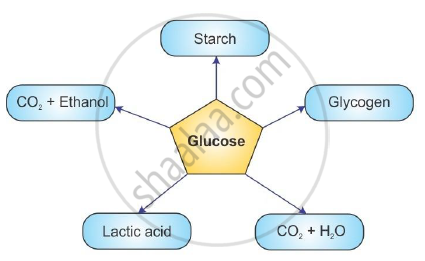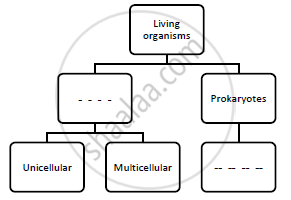Advertisements
Advertisements
Question
Give scientific reason.
Oxygen is necessary for complete oxidation of glucose.
Solution
- Glucose can be oxidized in two pathways i.e. aerobic and anaerobic respiration.
- A molecule of glucose is completely oxidized in aerobic respiration (i.e. in the presence of oxygen) to form \[\ce{CO2, H2O,}\] and energy (38 ATP), via. three steps namely glycolysis, Krebs cycle, and electron transfer chain.
- However, in anaerobic respiration (i.e. in absence of oxygen), glucose is incompletely oxidized via. glycolysis and fermentation, resulting in the formation of organic acids or alcohols and lesser amount of energy is obtained.
Hence, oxygen is necessary for the complete oxidation of glucose.
RELATED QUESTIONS
Given below are the end products of different reactions involving glucose. Write the appropriate end product in front of the following:

(1) Anaerobic reaction =
(2) Reaction in human muscles =
(3) Aerobic respiration
(4) Reaction in plant cells =
(5) Reaction in liver =
Name the life process of an organism that helps in the growth of its population.
Why is diffusion insufficient to meet the oxygen requirements of multi-cellular organisms like humans
Which of the following type of energy is used by living organisms to perform vital life processes? Kinetic energy, Chemical energy, Potential energy, Nuclear energy
Match the organisms given in column I with the processes given in column II:
| Column I | Column II | ||
| (i) | Leech | (a) | Holozoic nutrition |
| (ii) | Amoeba | (b) | Autotrophic nutrition |
| (iii) | Mushroom | (c) | Parasitic nutrition |
| (iv) | Green plant | (d) | Saprophytic nutrition |
Match the terms in column I with their uses in column II
| Column I | Column II |
| (i) Heart | (a) Pipes for transport in humans |
| (ii) Arteries and Veins | (b) Clotting of blood |
| (iii) Xylem vessels | (c) Pumping organ |
| (iv) RBC | (d) Water transport in plants |
| (v) Platelets | (e) Carrier of oxygen |
A person lives near a forest. Make a list of four items which he can get from the forest to meet his daily needs.
Name the green dot like structures in some cells observed by a student when a leaf peel was viewed under a microscope. What is this green colour due to?
Skin : Keratin : : Blood : ____________
Complete the following flowchart.
Write definition.
Nutrition.
Write the definition.
Proteins
Write definition.
Glycolysis
Give scientific reason.
Kreb's cycle is also known as citric acid cycle.
Answer in detail.
How all the life processes contribute to the growth and development of the body?
Answer in detail.
Explain the Kreb's cycle with reaction.
Explain the ‘inhalation’.
Name the organs that form the excretory system in human beings.
Explain the Steps of Glycolysis.
Choose the forms in which most plants absorb nitrogen
- Proteins
- Nitrates and Nitrites
- Urea
- Atmospheric nitrogen
How do the guard cells regulate opening and closing of stomatal pores?
Why do fishes die when taken out of water?
Match the words of Column (A) with that of Column (B)
| Column A | Column B |
| Phloem | (i) Excretion |
| Nephron | (ii) Translocation of food |
| Veins | (iii) Clotting of blood |
| Platelets | (iv) Deoxygenated blood |
In each of the following situations what happens to the rate of photosynthesis?
- Cloudy days
- No rainfall in the area
- Good manuring in the area
- Stomata get blocked due to dust
Explain the following concept in short:
Role of circulatory system in energy production
Classify vitamins according to their solubility.
Give one example of each of the classifications of vitamins.
